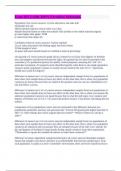Exam (elaborations)
Econ 203 || with 100% Errorless Solutions.
- Course
- Institution
Hypothesis Test correct answers 1) form alternative and state null 2)calculate test stat 3)find rejection region's critical value or p value 4)make decision based on where test statistic falls (within or not within rejection region) (p value higher than alpha= DNR p value lower than alpha=R) ...
[Show more]



